Hotpoint WD645, WD440, WD420, WD640 User Manual

Instructions for Installation and Use
6kg Washer Dryer Aquarius
Aquarius+
To the Installer:
Before installation, fill in the product details on the back cover of this book. The information can be found on the rating plate.
To the User:
You must read these instructions prior to installing and using the appliance and then retain them for future reference.
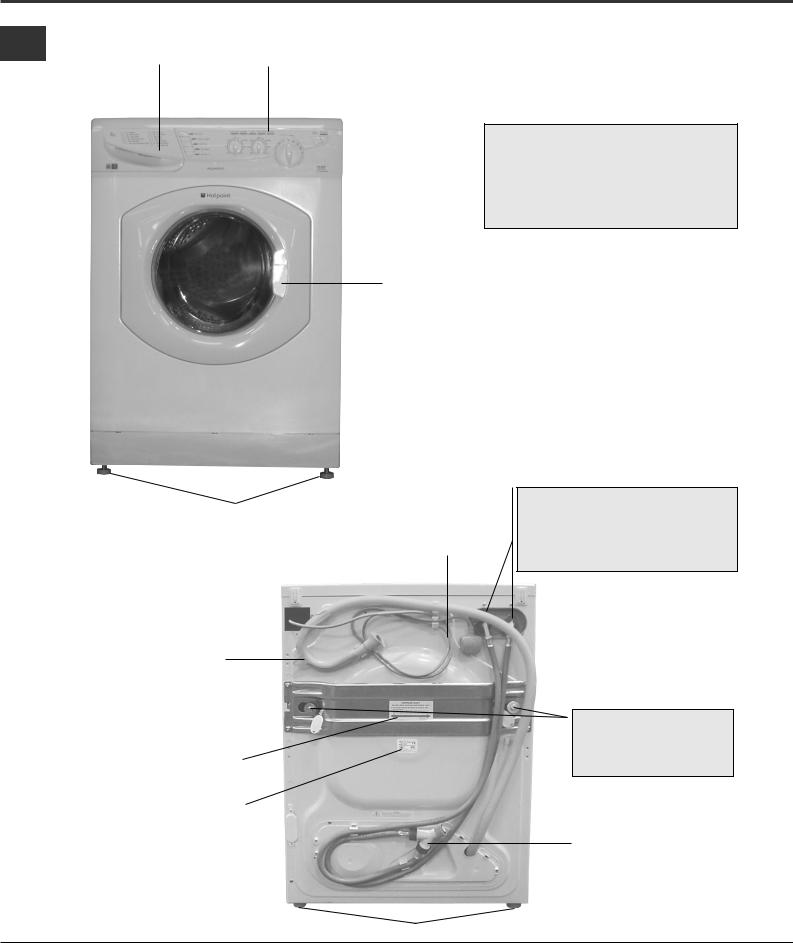
Description
GB
Dispenser drawer Control panel
(● Varies by Model)
● Please record the Model number and
Serial number of your machine on the back cover of this book for future reference.
- The Serial number can be found on the inside door trim.
Interlocking door and release lever.
Cold water inlet points Front adjustable feet and attached fill hoses (blue connectors)
Drainage hose |
Mains cable |
|
|
Hooked end support
! DO NOT remove either of the attached fill hoses OR the ‘Y’ piece connector, even if you have both Hot and Cold water supplies (see page 7).
Two transit fixings
! BOTH must be removed BEFORE you use your
Plumbing indicator line
machine (see page 6).
Rating plate
‘Y’ piece connector
Back feet
2
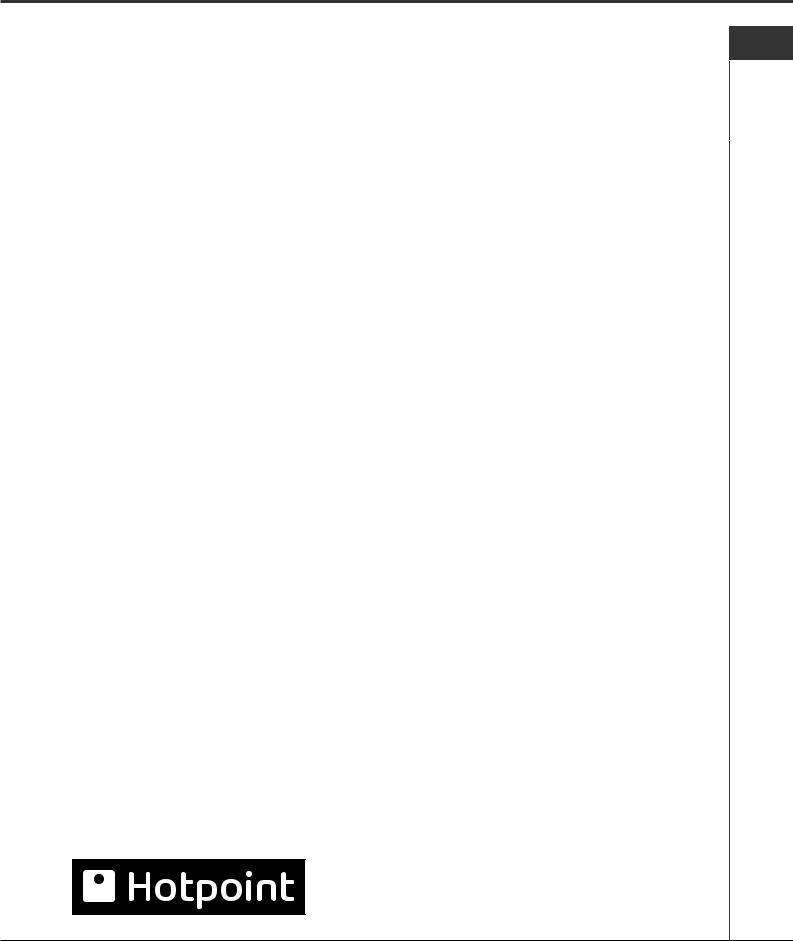
Contents
WASHER DRYER
Description, 2
Wash Labels Explained, 4
Installation, 5-8
Unpacking
Remove the transit fixings
Location
Levelling
Water connection
Drainage connection
Electrical connection
Before you start using your machine
Control Panel Features, 9
Aquarius
Aquarius+
Programmes and Option Modifiers, 10-16
Starting a wash and dry programme
Drying
Programme table
Option modifiers and special features
Detergents and Laundry, 17
Detergent dispenser
Care and Maintenance, 18
Cleaning your machine
Fuses
Changing the plug
Precautions and Advice, 19-20
General safety
Saving energy and respecting the environment
Disposal
Something Wrong? - Troubleshooting, 21-23
Service, 24
Before calling for assistance
Spare parts
Key Contacts
! Keep this instruction book on hand in order to refer to it when necessary. Take it with you when you move, and should you sell this appliance or pass it on to another party, make sure that this booklet is supplied along with the appliance so that the new owner may be informed about warnings and suggestions on how the machine works.
GB
Description |
|
|
Contents |
|
|
|
|
|
Explained |
Labels Wash |
|
|
|
|
Installation |
|
|
|
|
|
Features |
Panel Control |
|
|
|
|
Modifiers |
Option and |
Programmes |
|
|
|
Laundry and |
Detergents |
|
|
|
|
Maintenance |
and Care |
|
|
|
|
Advice and |
Precautions |
|
|
|
|
Troubleshooting |
- Wrong |
Something |
|
|
|
Service |
|
|
3
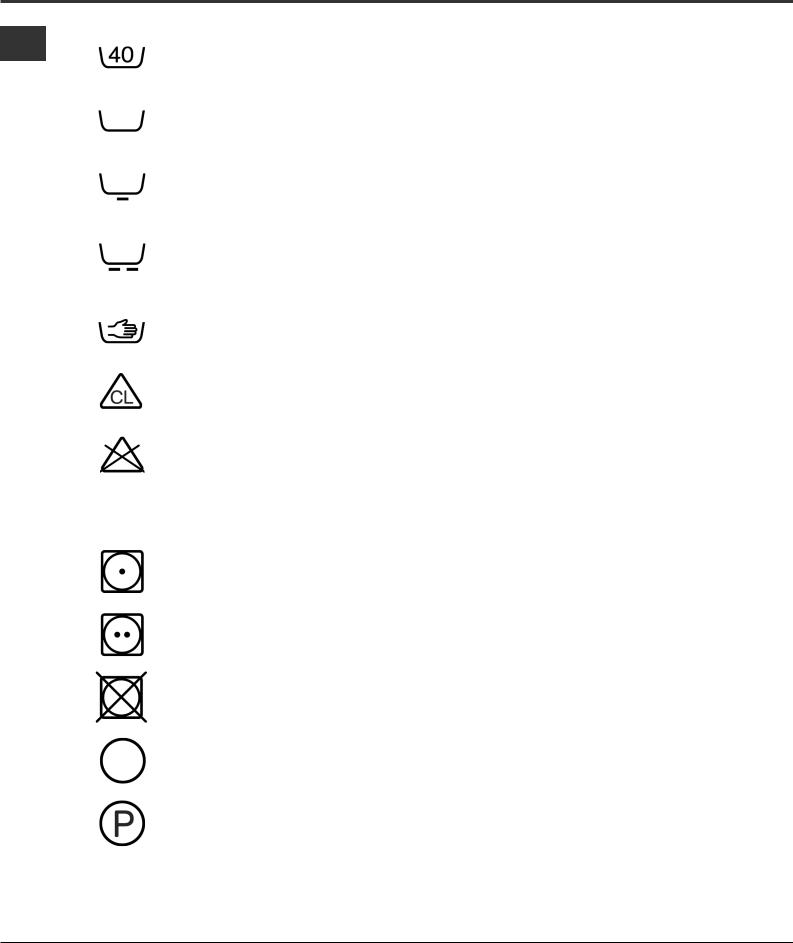
Wash Labels Explained
GB
The number inside the wash tub shows the maximum water temperature, in ˚C.
If there are no bars, the garment can be spun and rinsed as normal.
One bar indicates a reduced spin speed programme should be used.
Two bars mean the clothes need a mild wash action, but can be spun and rinsed normally. Such items should not be wrung out by hand.
If the tub contains a hand, wash the item on a Hand Wash programme.
A triangle means that you can safely use a cold, dilute solution of bleach.
A triangle with a cross over it means the item cannot be bleached.
A circle inside a square means you can tumble dry the garment.
The dots indicate temperature
-one dot for lower heat.
-two dots for higher heat.
A cross over this symbol shows you should not tumble dry the garment.
A circle means the garment is suitable for dry-cleaning.
A letter inside the circle is to tell the dry-cleaner which chemical wash and method to use.
4
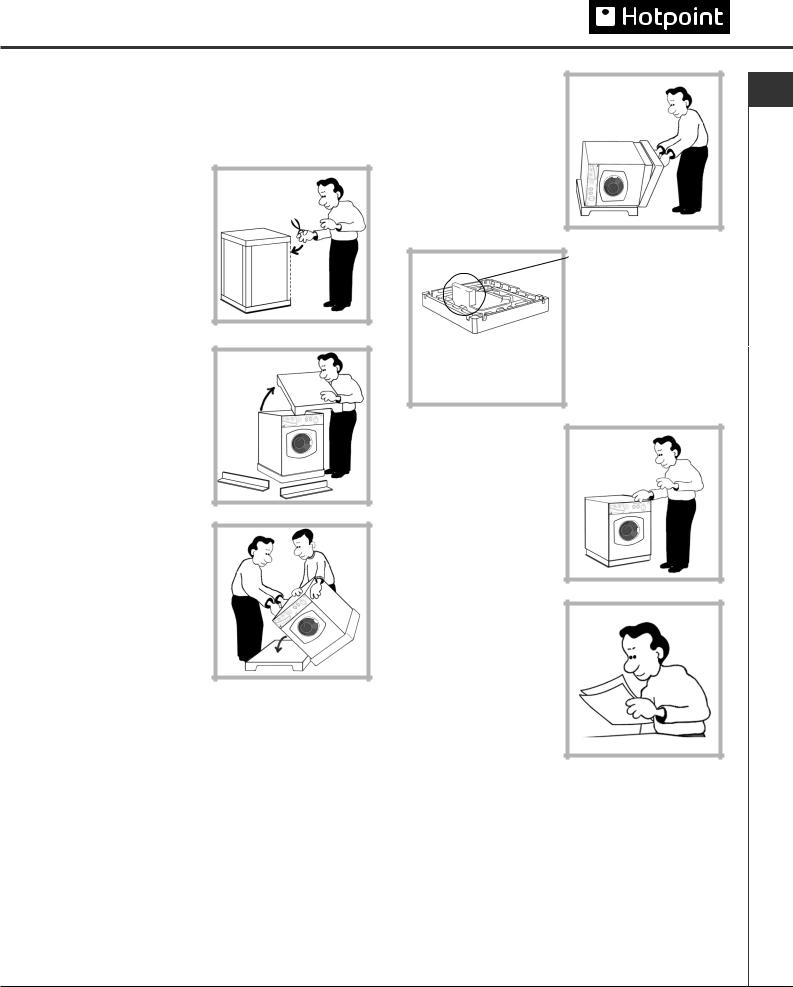
Installation
! Read these instructions carefully: the following pages contain important information on installation and suggestions on how the appliance works.
Unpacking
1. Using scissors, cut carefully along one corner post to remove the film.
2. Lift off the polystyrene top cap and remove the four corner posts.
3. Carefully lay the left side of the machine down onto the top cap.
! We recommend that a second person helps to raise and lower the machine.
4. Remove the polystyrene base.
! IMPORTANT check when unpacking your machine:
5. Stand the machine upright.
! We recommend that a second person helps to raise and lower the machine.
! Continue to read the rest of these instructions carefully; the following pages contain important information on installation and troubleshooting.
!This is a part of the polystyrene base and should have stayed intact when you removed the base.
!If it has broken off and is still in the machine...
remove it... while the machine is still laying on its side on the top cap.
! Protect the environment - please dispose of the packaging material carefully and considerately.
GB
Description |
|
|
|
|
|
Contents |
|
|
|
|
|
Explained |
WashLabels |
|
Installation |
|
|
|
|
|
Features |
ControlPanel |
|
Modifiers |
andOption |
Programmes |
|
|
|
andLaundry |
Detergents |
|
|
|
|
Maintenance |
Careand |
|
|
|
|
andAdvice |
Precautions |
|
|
|
|
Troubleshooting |
Wrong- |
Something |
Service |
|
|
5
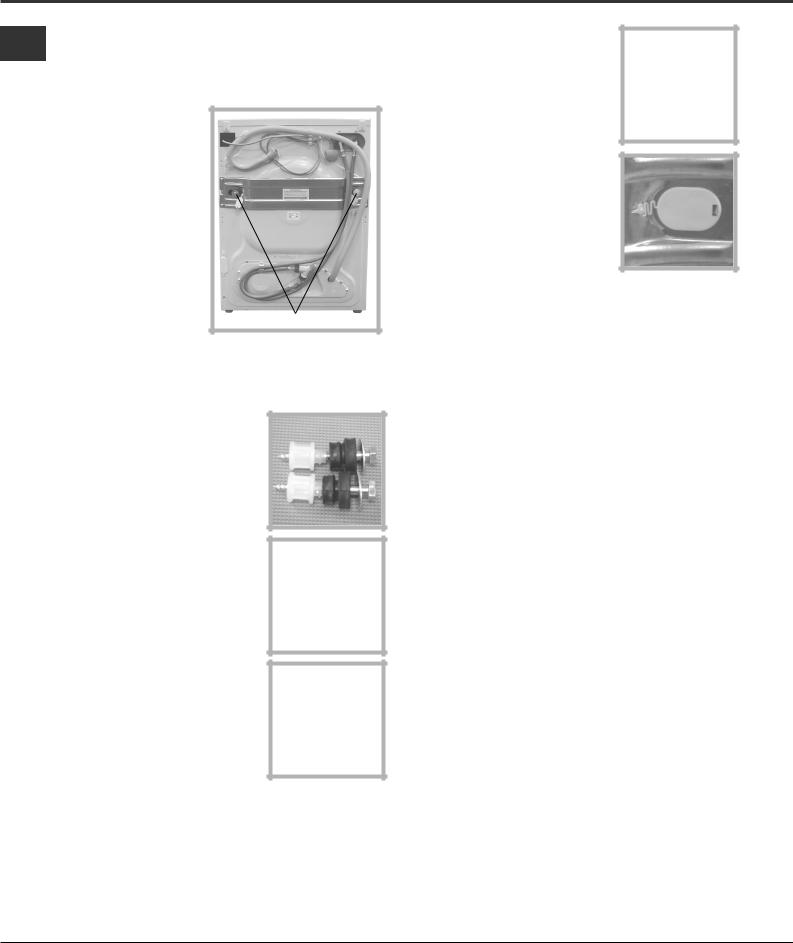
Installation
Remove the transit fixings
GB
IMPORTANT: Follow these instructions to remove the TWO transit fixings (see Description for location).
! Situated one either side of the rear panel,
BOTH transit bolts MUST be removed before use.
Location of transit bolts.
!Failure to do so may cause damage to your machine.
!It is important the TWO transit fixings come out intact.
!Be sure to remove TWO bolts,
TWO washers, TWO rubber grommets and TWO nylon spacers (see pic).
1. Unscrew the bolt using a 13mm spanner.
2. STOP when 3 threads can be seen.
3. Hold, slide sideways and pull to remove.
4. For safety, insert one of the the plastic covers (supplied with your machine) over the hole.
!Repeat steps 1 to 4 to remove the second transit bolt.
!Packaging materials are not children's toys.
Location
Where you install your machine will affect its performance:
! For your safety and to comply with electrical regulations, seek professional advice if you want to install your machine in a bath or shower room.
●Make sure that the electrical socket and water taps are easily accessible. You should switch off the machine’s electrical and water supplies when you are not using it for extended periods.
●Make sure that you allow enough space for the machine. Select a space at least 60cm wide, 60cm deep and 85cm high. Also leave enough space to open the door fully, so that you can load and unload it easily.
●Where possible, the machine should be positioned on a solid floor to minimise vibration.
! Take care when you move the machine not to rip any floor coverings. The weight of the machine may cause indentations in some floor coverings.
Did you know?...
●...the transit fixings are fitted to ensure that your machine is undamaged during delivery.
●...both of the transit fixings MUST BE removed before using the machine, be sure to remove TWO bolts, TWO washers, TWO rubber grommets and TWO nylon spacers, not doing so will lead to excessive vibration, movement of the machine and could eventually lead to internal damage.
●...the majority of problems with noisy machines are due to the transit fixings not being removed.
●...you will be charged for a service engineers visit if a problem with your machine is caused by incorrect installation or misuse.
6
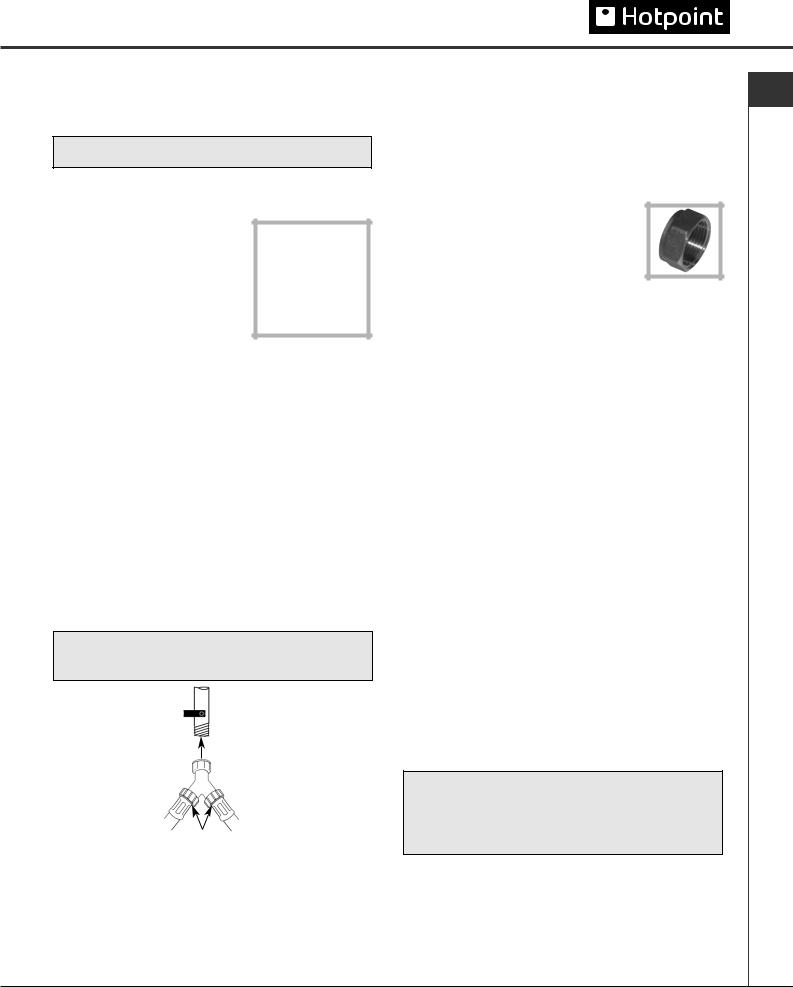
Installation
Levelling
Your machine will be noisy if the two front feet are not adjusted so that the machine stands firm and level.
! The machine must be levelled from side to side and from front to back.
1.Move your machine into its final location, taking care not to trap or kink the hoses.
2.Turn one or both front feet
anti-clockwise by hand until the feet cannot be turned any more. When adjusting the feet, use a spirit level to check the machine stands level, from side to side and from front to back.
The spring on each foot will stop them coming loose.
! If it is placed on a fitted or loose carpet, adjust the feet in such a way as to allow enough room for ventilation beneath the machine.
Water Connection
Connecting the cold water inlet hoses with the ‘Y’ piece connector.
!Remember: please use the new hoses supplied, fitted to the machine. Old hoses may cause leaks due to worn out washers or may be split due to water pressure.
!Remember: This is a cold-fill machine... BOTH fill hoses (blue connectors) fitted to the rear of the machine MUST be connected to the COLD water supply (via the ‘Y’ piece connector).
!Before making connections to the cold water supply, allow the water to run freely from the supply tap until it is perfectly clear.
COLD
WATER
SUPPLY
 ‘Y’ piece connector
‘Y’ piece connector
Cold water fill hose (Blue Connectors)
1.Screw the ‘Y’ piece connector onto the cold water supply until tight.
2.Fit a 3/4" sealing cap to the hot water supply, to prevent unused supply leaking.
3.Turn ON the COLD water supply tap and check for leaks, tighten if necessary.
4.Leave the unused HOT water supply turned OFF.
! We recommend fitting a 3/4" sealing cap to the hot water supply tap (if present), to ensure there are no leaks. Sealing caps can be purchased from Hotpoint Service on 08709 077 077 or all good DIY and Plumbing outlets.
Benefits of cold fill
●Modern detergents are designed to give the best cleaning results at low temperatures. Biological detergents contain enzymes which are active between 30˚C and 53˚C, giving greater results at lower temperatures.
●Cold water relaxes fabrics, whilst hot water can seal in stains.
●Improved stain removal with cold water.
●The most commonly used programme at present is 40˚C, which will take on cold water even if hot and cold were available.
●You can heat the water required to finish the wash cycle, which makes it more economical than taking water heated in a tank by an immersion heater or gas boiler.
Hints and tips
!Make sure there are no kinks or bends in the hose.
!The water pressure at the supply tap must be within the values indicated in the Technical Details table (see page 20).
!If the water inlet hoses are not long enough, you can purchase an extended hose from Hotpoint Service on 08709 077 077.
!Always use a new inlet hose.
!Check the water inlet hose at least once a year, replace if cracked as worn hoses could split under water pressure.
!Turn on the water supply and check that the connections do not leak. If there is a leak, turn off the water supply, disconnect the hoses and check that the sealing washers are in place. Refit the hoses and turn on the water supply.
Did you know?...
●...the most common cause of problems with water connection is that the customer has not turned the supply tap on..
●...it is very important to ensure that your hoses or cables are not kinked or squashed when the machine is pushed back into its location, as this can lead to your machine failing to fill or empty the water.
●...the majority of problems with noisy machines are due to the feet not being adjusted correctly to level the machine.
GB
Description |
|
|
|
|
|
Contents |
|
|
|
|
|
Explained |
WashLabels |
|
|
|
|
Installation |
|
|
|
|
|
Features |
Panel |
Control |
|
|
|
Modifiers |
andOption |
Programmes |
|
|
|
andLaundry |
Detergents |
|
|
|
|
Maintenance |
Careand |
|
|
|
|
andAdvice |
Precautions |
|
|
|
|
Troubleshooting |
Wrong- |
Something |
Service |
|
|
7
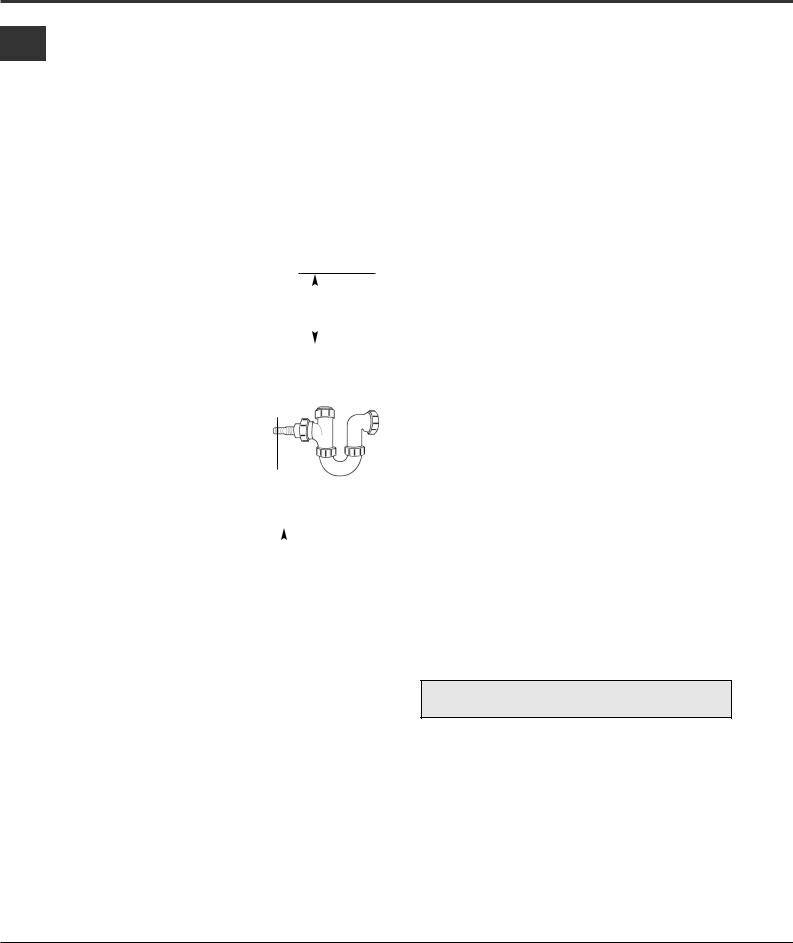
Installation
Drainage Connection
GB
!Although you may need to move the hooked end support along the grey drainage hose, DO NOT remove it.
!Whichever drainage method you use, make sure that the hooked end support is fixed level to, or above the ‘Plumbing Indicator Line’ (see Description page 2).
We recommend one of the following: |
|
|
|
|
||
Standpipe method: |
|
|
|
|
||
1. Make sure the standpipe |
|
|
|
|
|
|
|
|
|
Hooked end |
|
||
height is a minimum 500mm up to |
|
|
|
|
||
|
|
|
|
|||
|
|
|
support |
|
||
a maximum 1200mm from the |
|
|
|
|
|
|
floor. |
|
|
|
|
|
|
|
|
|
|
|
|
|
2. Insert the drainage hose |
|
|
|
|
minimum: |
|
approximately 100mm into the |
|
|
|
|
500mm |
|
|
|
|
|
maximum: |
|
|
standpipe. |
|
|
|
|
1200mm |
|
|
|
|
|
|
||
|
|
|
|
|
|
|
|
|
|
|
|
|
|
Under sink method: |
|
|
|
|
||
1. Cut off the blocked end of the |
|
|
|
|
|
|
|
|
|
|
|
||
under sink drainage unit, or |
|
|
|
|
|
|
remove the blanking plug if fitted. |
|
|
|
|
|
|
|
|
|
|
|
|
|
2. Fix the hooked end support a |
|
|
|
|
minimum of 800mm from the |
|
|
|
|
floor. |
|
|
|
|
3. Use a hose clip (eg. a jubilee |
|
|
||
|
Hose clip |
|
|
|
|
|
|||
clip) to securely attach the grey |
|
minimum: |
||
drainage hose end to the under |
|
800mm |
||
|
from floor |
|||
sink drainage unit. |
|
|
|
|
Electrical connections
Before plugging the appliance into the mains socket, make sure that:
●the socket is earthed and in compliance with the applicable law.
●the socket is able to sustain the appliances maximum power load indicated in the Technical Details table (see page 20).
●the supply voltage is included within the values indicated in the Technical Details table (see page 20).
●the socket is compatible with the machines plug. If this is not the case, replace the socket or the plug, ensuring a 13A fuse is fitted.
!The machine should not be installed in an outdoor environment, not even when the area is sheltered, because it may be very dangerous to leave it exposed to rain and thunderstorms.
!When the machine is installed, the mains socket must be within easy reach and should be connected to a suitable electrical supply.
!Do not use extensions or multiple sockets.
!The power supply cable must never be bent or dangerously compressed.
!The power supply cable must only be replaced by an authorised serviceman.
!The company denies all liability if and when these standards are not respected.
Before you start using your machine
The first wash cycle
Once the appliance has been installed and before you use it for the first time, run a wash cycle without detergent and no laundry. This will check your installation, connections and drainage and will thoroughly clean the interior before you carry out an actual wash programme on your laundry.
This will take approximately 21/2 hours to complete.
!Run the 95˚ White Cotton programme 'B', without laundry and without detergent.
!During this cycle check for any leaks from under the machine. If present ensure all hoses are securely tightened.
Did you know?...
●...it is very important to ensure that your hoses or cables are not kinked or squashed as this can lead to your machine failing to fill or empty the water.
●...it is very important to respect the dimensions given within the drainage connection methods (see above).
●...if using the undersink drainage method remember to cut off the blocked end, or remove the blanking plug.
●...you will be charged for a service engineers visit if a problem with your machine is caused by incorrect installation or misuse.
8
